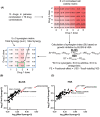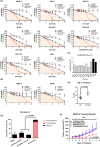Combined inhibition of histone methyltransferases EZH2 and DOT1L is an effective therapy for neuroblastoma
- PMID: 39501501
- PMCID: PMC11538032
- DOI: 10.1002/cam4.70082
Combined inhibition of histone methyltransferases EZH2 and DOT1L is an effective therapy for neuroblastoma
Abstract
Background: The child cancer, neuroblastoma (NB), is characterised by a low incidence of mutations and strong oncogenic embryonal driver signals. Many new targeted epigenetic modifier drugs have failed in human trials as monotherapy.
Methods: We performed a high-throughput, combination chromatin-modifier drug screen against NB cells. We screened 13 drug candidates in 78 unique combinations.
Results: We found that the combination of two histone methyltransferase (HMT) inhibitors: GSK343, targeting EZH2, and SGC0946, targeting DOT1L, demonstrated the strongest synergy across 8 NB cell lines, with low normal fibroblast toxicity. High mRNA expression of both EZH2 and DOT1L in NB tumour samples correlated with the poorest patient survival. Combination HMT inhibitor treatment caused activation of ATF4-mediated endoplasmic reticulum (ER) stress responses. In addition, glutathione and several amino acids were depleted by HMT inhibitor combination on mass spectrometry analysis. The combination of SGC0946 and GSK343 reduced tumour growth in comparison to single agents.
Conclusion: Our results support further investigation of HMT inhibitor combinations as a therapeutic approach in NB.
Keywords: biomarkers; cancer biology; chromatin modifications and dynamics; epigenetics; molecular biology; neuroblastoma.
© 2024 The Author(s). Cancer Medicine published by John Wiley & Sons Ltd.
Conflict of interest statement
The authors do not have a conflict of interest to declare.
Figures





Similar articles
-
Synergistic antitumor effect of combined EZH2 and DOT1L inhibition in B-cell lymphoma.Blood. 2025 Jun 12;145(24):2873-2886. doi: 10.1182/blood.2024026534. Blood. 2025. PMID: 40009485
-
Druggable epigenetic suppression of interferon-induced chemokine expression linked to MYCN amplification in neuroblastoma.J Immunother Cancer. 2021 May;9(5):e001335. doi: 10.1136/jitc-2020-001335. J Immunother Cancer. 2021. PMID: 34016720 Free PMC article.
-
The Histone Methyltransferase DOT1L Promotes Neuroblastoma by Regulating Gene Transcription.Cancer Res. 2017 May 1;77(9):2522-2533. doi: 10.1158/0008-5472.CAN-16-1663. Epub 2017 Feb 16. Cancer Res. 2017. PMID: 28209620
-
Targeting histone methyltransferases and demethylases in clinical trials for cancer therapy.Clin Epigenetics. 2016 May 24;8:57. doi: 10.1186/s13148-016-0223-4. eCollection 2016. Clin Epigenetics. 2016. PMID: 27222667 Free PMC article. Review.
-
Emerging EZH2 Inhibitors and Their Application in Lymphoma.Curr Hematol Malig Rep. 2018 Oct;13(5):369-382. doi: 10.1007/s11899-018-0466-6. Curr Hematol Malig Rep. 2018. PMID: 30112706 Review.
References
-
- Keshelava N, Seeger RC, Groshen S, Reynolds CP. Drug resistance patterns of human neuroblastoma cell lines derived from patients at different phases of therapy. Cancer Res. 1998;58:5396‐5405. - PubMed
-
- Webster RM. Combination therapies in oncology. Nat Rev Drug Discov. 2016;15:81‐82. - PubMed
-
- Boeva V, Louis‐Brennetot C, Peltier A, et al. Heterogeneity of neuroblastoma cell identity defined by transcriptional circuitries. Nat Genet. 2017;49:1408‐1413. - PubMed
MeSH terms
Substances
Grants and funding
LinkOut - more resources
Full Text Sources
Medical
Molecular Biology Databases

